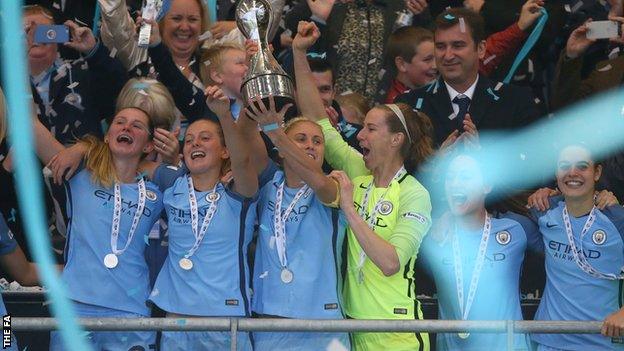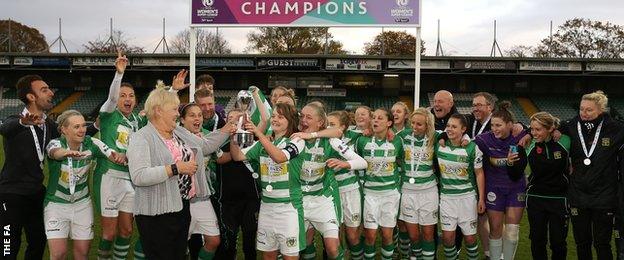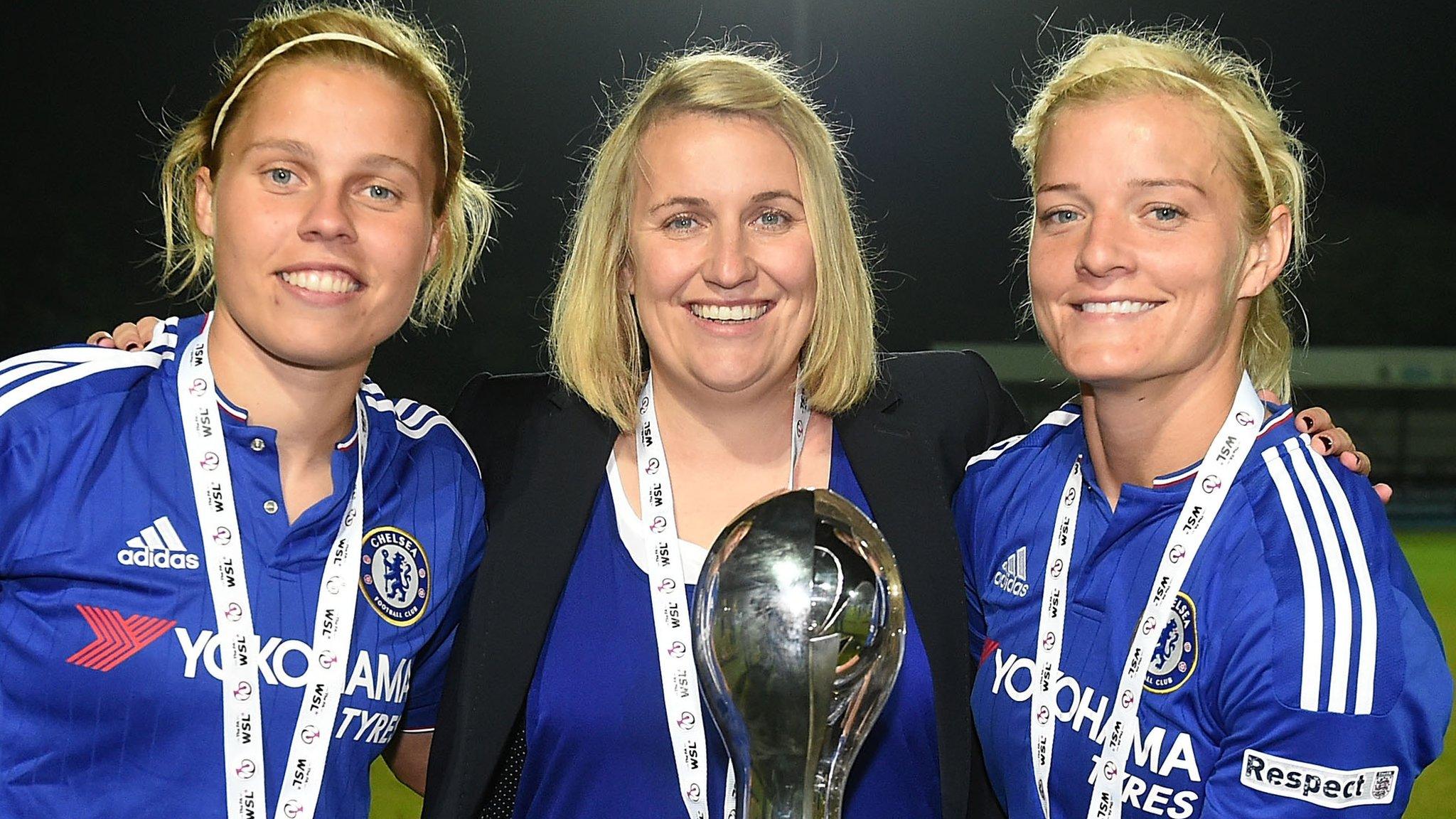Women's Super League: FA considers one-tier full-time league from 2018-19
- Published

Manchester City won their first Women's Super League One title in 2016
The Women's Super League could turn in to a one-tier league strictly for clubs that can sustain full-time players from 2018-19 onwards, BBC Sport has learned.
WSL 2, which started in 2014, will be a part-time league and may be rebranded.
A consultation period to discuss the plans is under way between the Football Association and the 20 WSL clubs.
Under the proposals, part-time clubs currently in WSL 1 could potentially be moved in to the second division irrespective of their 2017-18 results.
When the WSL - which began in 2011 and is run by the FA - was expanded to include a second tier in 2014, Doncaster Rovers Belles were controversially replaced by then WSL newcomers Manchester City, because the Belles did not retain a top-tier licence upon reapplication.
BBC Sport understands some currently part-time clubs are uneasy about the prospect of their 2018-19 league status being determined by off-field criteria over their league results when they reapply.
The promotion and relegation provisions in place for the upcoming season's rules will also be taken into account during the relicensing process, but to what extent is not yet clear.
Among the proposals, top-tier clubs would be required to run a youth academy, replacing the current development league for younger players.
It is understood the plans are aimed at offering better support to the England national teams, maintaining the competiveness of the WSL and bolstering English clubs' chances in the Women's Champions League.
As the existing WSL teams' licences end following the 2017-18 season, the new proposals - if approved - will affect the criteria for 2018-19 licences.
Any decisions would need the approval of the FA's women's football board, which meets later in September.
What are the new proposals?
BBC Sport understands plans for the new top flight include:
Between eight and 14 teams with full-time professional players
A minimum of 16 contact hours per week for players, rising to 20 hours per week by 2020-21
Entry via a licence system, with a minimum level of investment required by each club
Financial Fair Play regulations and a squad cap
An academy at each club, compulsory as part of the licence
Rules restricting the number of non-English-qualified players in matchday squads would also be continued, as the FA bids to enhance opportunities for home-grown talent.
An entirely full-time top-flight women's league would be a rarity in European women's football, with most major nations having less than three entirely professional clubs.
A new second tier with a new name?

Tottenham were promoted to WSL 2 for the first time last season
BBC Sport understands one aim of the proposals is to provide a clear distinction between the professional and semi-professional tiers of the women's game in England.
While research is still to be finalised regarding the possible rebranding of WSL 2 as a new division, one name under consideration for the second tier is understood to be "The FA Women's Football National League".
The new second tier, separate to the WSL, would include:
Between 10 and 12 teams, consisting of part-time players
Contact time for players of eight hours per week plus matches
A reserve team operated by each club, but no strict requirement to run an academy
The regional divisions of the Women's Premier League would remain as the third and fourth tier within the English women's football pyramid.
What does the WSL currently look like?
The WSL consists of 20 teams, with 10 sides in each division, having initially started with eight clubs in 2011.
The 2017-18 winter WSL season - the first since a transition from the previous summer calendar - begins on Friday, 22 September.
In April, top-flight outfit Notts County Ladies folded on the eve of the 2017 Spring Series, leaving players "jobless and homeless".
That prompted the FA to invite WSL 2 clubs to bid to replace Notts in the top tier and, in June, Everton Ladies - winners of the WSL 2 Spring Series - were confirmed as the successful bidders.
Everton have since stepped up to full-time status in preparation for the winter season, but some other clubs in the existing top division still operate on a part-time basis.
Is a full-time women's league sustainable?

Part-time outfit Yeovil won the WSL 2 title in 2016 and will play in the top flight for 2017-18
While clubs at the top end of the WSL have invested significantly in the women's game in recent years, amid growing attendances and blossoming exposure for the national team, others have struggled to afford it.
Last winter, WSL side Sunderland opted to revert back to semi-professional status, and Notts' demise soon followed.
However, last year the FA invested more in the women's game than any other European governing body.
This year the FA has undertaken a review of the performance system for the women's game, led by new head of women's football performance, David Faulkner.
In March, the FA's 'Gameplan for Growth' launch targeted doubling participation in the women's game by 2020 and, the FA has since confirmed their intention to bid to host the Women's European Championships in 2021 following England's run to the semi-finals of Euro 2017.
With the new plans, the FA want to improve the player development pathway, grow the women's game's fan base and attract an increase in commercial and broadcast revenues.
Analysis - the challenge for the FA
Katie Gornall, BBC Sports Correspondent:
The FA WSL has already gone through several incarnations since its inception in 2011. The latest proposal is a bold move to try and set minimum standards across the board, increase investment and build on the growing interest in women's football.
Whilst efforts to make the league more professional and competitive should be applauded, and will be welcomed by the top clubs, there will be those who question whether this is too much too soon.
Previous changes to the league such as the move to a winter competition, the introduction of promotion and relegation, and the inconsistency that has resulted has left certain teams struggling to build a fan base.
Those teams that have earned their current position on merit and may find it difficult to meet the new criteria are sure to raise concerns, and there will be fears that some clubs will offload their women's sides if they are forced out of the top flight.
The challenge for the FA is to improve the product and make it more attractive to fans and broadcasters without making it unsustainable, and without cutting the smaller clubs adrift. Not straightforward.
- Published12 July 2016

- Published9 June 2017
